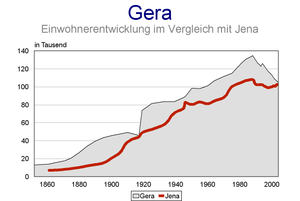Population development of Gera
The population development of Gera describes the population development of the city of Gera .
Population development of Gera
Following is an overview of the number of inhabitants from Gera to the respective territorial status. Up to 1833 these are mostly estimates, then census results (¹) or official updates from the State Central Administration for Statistics (until 1989) and the State Statistical Office (from 1990). From 1871, the information relates to the “local population”, from 1925 to the resident population and since 1966 to the “population at the place of the main residence”. Before 1871, the number of inhabitants was determined according to inconsistent survey procedures.
The population development can be divided into three phases:
Phase 1: Pre-industrial times
(respective territorial status)
Until 1850 the population of the city of Gera grew only moderately and even fell temporarily after the city fire of 1780. After the spinning machine was introduced in 1811 and the loom in 1836 , growth accelerated due to industrialization.
|
¹ census result
Phase 2: 1850 to 1989
(respective territorial status)
After 1850 Gera developed into an important industrial city. The textile industry was of the greatest importance and was to remain so until 1989. The number of inhabitants also developed accordingly. The sharp increases between 1910 and 1925 and between 1946 and 1950 can be traced back to the waves of incorporation in the years 1919 to 1923 and 1950. The sharp rise in the population from 1970 to 1989 to the historic high of around 135,000 can in turn be traced back to the promotion of Geras as a district town and the resulting construction of the Lusan and Bieblach-Ost development areas . During this time, the city also played an important role as a place of residence for the friends of the SDAG Wismut . The development until 1989 shows certain parallels with the third largest city at the time of Thuringia , Jena on.

|
|
¹ census result
Phase 3: Since 1990
(respective territorial status)
On December 31, 2009 the “ official population ” for Gera was 99,987 according to the Thuringian State Office for Statistics (only main residences and after comparison with the other State Offices). The city has thus lost 34,847 inhabitants since the fall of the Wall in the GDR. In 1988 the city had 134,834 inhabitants according to the then valid territorial status. The decline in the population between 1991 and 1997 is remarkable despite the wave of incorporation in 1994. The reason for this is the sharp decline in the birth rate at the beginning of the 1990s and the labor market- related emigration that began with the collapse of Gera’s industry. In 2007 Jena overtook the city of Gera in terms of population. With this, Jena, which, contrary to the current trend in East Germany , was able to stabilize its population due to the high number of students, has replaced Gera as the second largest city in Thuringia. In 2009 Gera lost its status as a big city and now has a population of less than 100,000 people. The population decline has slowed considerably since 2009 and has stabilized since 2012. For the first time since 1988, Gera recorded positive net migration of 92 people (main residences) in 2011. The fact that the number of inhabitants is still falling is due to the surplus of deaths, which could not be offset by a sufficient level of positive net migration. The number of deaths will remain almost the same in the next few years, as these parts of the population have hardly been affected by the significant emigration since the early 1990s, mostly due to their relatively old age.
|
|
|
See also
literature
- Imperial Statistical Office (Ed.): Statistical Yearbook for the German Empire , 1880–1918
- Statistisches Reichsamt (Ed.): Statistical yearbook for the German Reich , 1919–1941 / 42
- German Association of Cities (Ed.): Statistical Yearbook of German Communities , 1890 ff.
- State Central Administration for Statistics (Ed.): Statistical Yearbook of the German Democratic Republic , 1955–1989


